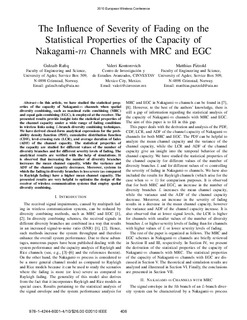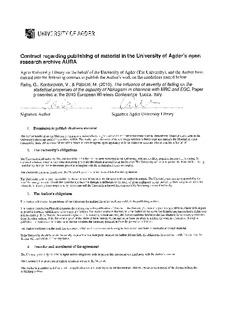| dc.contributor.author | Rafiq, Gulzaib | |
| dc.contributor.author | Kontorovich, Valeri | |
| dc.contributor.author | Pätzold, Matthias | |
| dc.date.accessioned | 2010-11-22T16:53:51Z | |
| dc.date.available | 2010-11-22T16:53:51Z | |
| dc.date.issued | 2010 | |
| dc.identifier.citation | Rafiq, G., Kontorovich, V., & Pätzold, M. (2010). The influence of severity of fading on the statistical properties of the capacity of Nakagami-m channels with MRC and EGC. Paper presented at the 2010 European Wireless Conference Lucca, Italy. | en_US |
| dc.identifier.isbn | 978-1-4244-6001-4 | |
| dc.identifier.uri | http://hdl.handle.net/11250/137830 | |
| dc.description | Paper presented at the 2010 European Wireless Conference , Lucca Italy. (c) 2010 IEEE. Personal use of this material is permitted. Permission from IEEE must be obtained for all other users, including reprinting/ republishing this material for advertising or promotional purposes, creating new collective works for resale or redistribution to servers or lists, or reuse of any copyrighted components of this work in other works. Paper also available from the publisher: http://dx.doi.org/10.1109/EW.2010.5483507 | en_US |
| dc.description.abstract | In this article, we have studied the statistical properties of the capacity of Nakagami-m channels when spatial diversity combining, such as maximal ratio combining (MRC) and equal gain combining (EGC), is employed at the receiver. The presented results provide insight into the statistical properties of the channel capacity under a wide range of fading conditions in wireless links using L-branch diversity combining techniques. We have derived closed-form analytical expressions for the probability density function (PDF), cumulative distribution function (CDF), level-crossing rate (LCR), and average duration of fades (ADF) of the channel capacity. The statistical properties of the capacity are studied for different values of the number of diversity branches and for different severity levels of fading. The analytical results are verified with the help of simulations. It is observed that increasing the number of diversity branches increases the mean channel capacity, while the variance and ADF of the channel capacity decreases. Moreover, systems in which the fading in diversity branches is less severe (as compared to Rayleigh fading) have a higher mean channel capacity. The presented results are very helpful to optimize the design of the receiver of wireless communication systems that employ spatial diversity combining. | en_US |
| dc.language.iso | eng | en_US |
| dc.publisher | IEEE | en_US |
| dc.title | The influence of severity of fading on the statistical properties of the capacity of Nakagami-m channels with MRC and EGC | en_US |
| dc.type | Academic article | en_US |
| dc.subject.nsi | VDP::Mathematics and natural science: 400::Information and communication science: 420::Communication and distributed systems: 423 | en_US |
| dc.subject.nsi | VDP::Technology: 500::Information and communication technology: 550::Telecommunication: 552 | en_US |
| dc.source.pagenumber | 406-410 | en_US |

